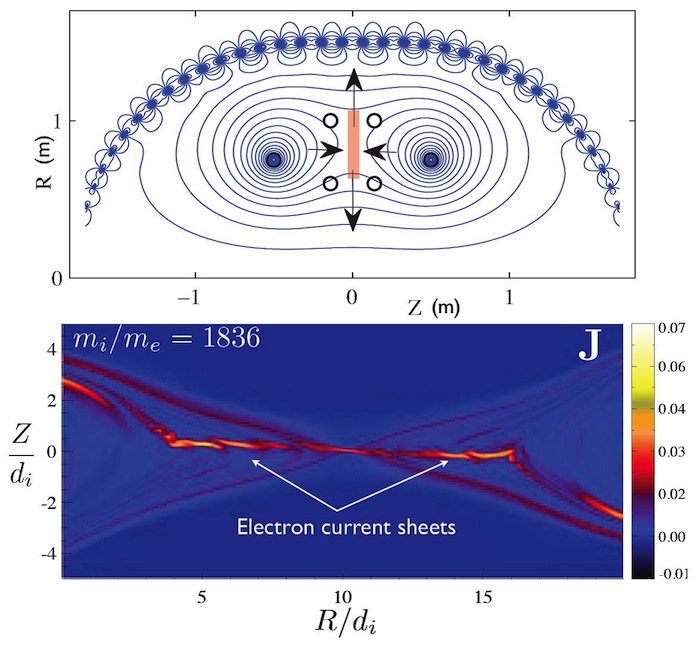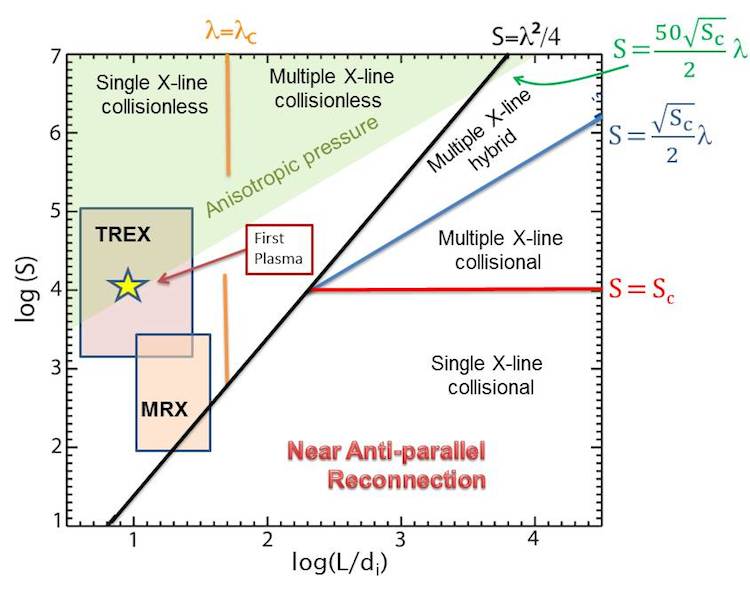Another emerging frontier is the study of kinetic effects in reconnection. So far the term “collisionless reconnection” has been applied to systems where the collisionallity may maintain the electron and ion distributions near Maxwellian; however, the collisionallity is sufficiently low to permit the fluid behaviors of the ions and electrons to decouple at the electron scale and to allow the Hall currents to become important. Alternatively, in fully collisionless plasma, non-Maxwellian distributions develop with pressure anisotropy that strongly impacts the properties of the reconnection process in ways not accounted for in traditional Hall reconnection. In fact, spacecraft observations and 2D kinetic simulations (at the full ion to electron mass ratio mi/me=1836) show that large scale electron jets and current layers are driven by electron pressure anisotropy that builds in the reconnection region due to kinetic electron trapping effects.
Compared to the Hall effects, the pressure anisotropy is much more sensitive to collisions as the time between electron collisions must be long compared to the full transit time of a fluid element through the reconnection layer. With the known inflow speed of reconnection (0.1vA) this constraint can be characterized as S > 10(mi/me)L/di. The anisotropy is particularly important to the dynamics of reconnection for the moderate guide-field case (where di ~ Ïs); the corresponding “anisotropic pressure region” of phase space is indicated in the Phase-diagram for moderate guide-field reconnection given in Figure 4. Recent work suggests that the parallel electric fields supported by the anisotropic pressure are important for electron energization [3]. In addition, the narrow current layers driven by the anisotropy may in 3D be unstable to reconnection at oblique angles, and thus, be important to the self-consistent evolution and generation of configurations with multiple X-line.
Figure 4: Reconnection phase space diagram identifying regimes of moderate guide-field reconnection spanned by the system size normalized to di and the Lundquist number S. Pressure anisotropy is expected for S > 104 and TREX is unique in its ability to address this regime experimentally.
To demonstrate how TREX is poised to explore issues related to the role of pressure anisotropy in 3D reconnection, Figure 5(top) shows one of several scenarios for driving reconnection in TREX. In this configuration the inflows are driven symmetrically (horizontally) which produce a vertical outflow region. Large scale current layers are expected to arise in the presence of a guide magnetic field sufficient in strength for magnetizing the electrons (Bg~0.2 Br). To aid the design of the experiments, kinetic simulations have been carried out at the plasma parameters expected for TREX. The kinetic simulation in Figure 5(bottom) is for full mass ratio mi/me=1836 and includes a collision operator corresponding to the collisionallity expected in TREX. In this simulation pressure anisotropy develops and drives the electron current layer extending to the system size. More details on the origin and importance of pressure anisotropy in reconnection are provided in a recent review paper on this topic [4] and is also discussed in the next section.

Figure 5: (top) Magnetic coil configuration for TREX implemented in the MPDX vacuum vessel. The bottom panel shows the current density for a 2D collisional VPIC simulation with mass ratio mi/me=1836 and collision frequency νee/ωee = 0.001.
[3] Egedal J, Daughton W, and Le A, â€?“Large scale electron energization by parallel electric fields during magnetic reconnection, (2012) Nature Physics, 8, 321-324, doi: 10.1038/NPHYS2249.
[4] Egedal J, Le A, and Daughton W, â€?“A review of pressure anisotropy caused by electron trapping in collisionless plasma, and its implications for magnetic reconnectionâ, (2013) Phys. Plasmas 20, 061201.
